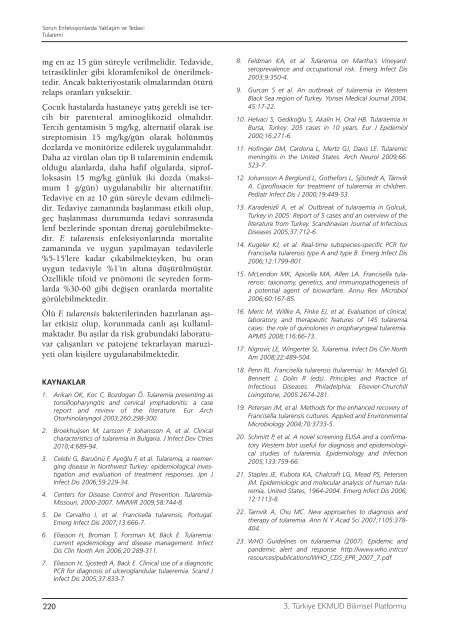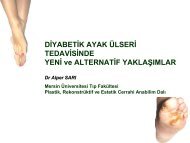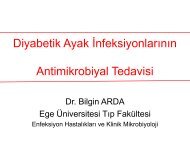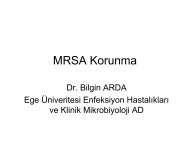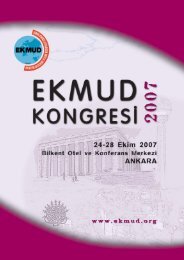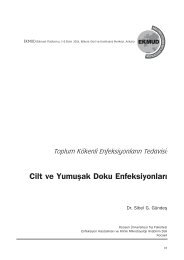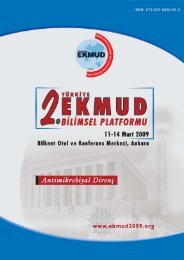HBV'de Tedavi - EKMUD
HBV'de Tedavi - EKMUD
HBV'de Tedavi - EKMUD
You also want an ePaper? Increase the reach of your titles
YUMPU automatically turns print PDFs into web optimized ePapers that Google loves.
Sorun Enfeksiyonlarda Yaklaşım ve <strong>Tedavi</strong>:<br />
Tularemi<br />
mg en az 15 gün süreyle verilmelidir. <strong>Tedavi</strong>de,<br />
tetrasiklinler gibi kloramfenikol de önerilmektedir.<br />
Ancak bakteriyostatik olmalarından ötürü<br />
relaps oranları yüksektir.<br />
Çocuk hastalarda hastaneye yatış gerekli ise tercih<br />
bir parenteral aminoglikozid olmalıdır.<br />
Tercih gentamisin 5 mg/kg, alternatif olarak ise<br />
streptomisin 15 mg/kg/gün olarak bölünmüş<br />
dozlarda ve monitörize edilerek uygulanmalıdır.<br />
Daha az virülan olan tip B tulareminin endemik<br />
olduğu alanlarda, daha hafif olgularda, siprofloksasin<br />
15 mg/kg günlük iki dozda (maksimum<br />
1 g/gün) uygulanabilir bir alternatiftir.<br />
<strong>Tedavi</strong>ye en az 10 gün süreyle devam edilmelidir.<br />
<strong>Tedavi</strong>ye zamanında başlanması etkili olup,<br />
geç başlanması durumunda tedavi sonrasında<br />
lenf bezlerinde spontan drenaj görülebilmektedir.<br />
F. tularensis enfeksiyonlarında mortalite<br />
zamanında ve uygun yapılmayan tedavilerle<br />
%5-15’lere kadar çıkabilmekteyken, bu oran<br />
uygun tedaviyle %1’in altına düşürülmüştür.<br />
Özellikle tifoid ve pnömoni ile seyreden formlarda<br />
%30-60 gibi değişen oranlarda mortalite<br />
görülebilmektedir.<br />
Ölü F. tularensis bakterilerinden hazırlanan aşılar<br />
etkisiz olup, korunmada canlı aşı kullanılmaktadır.<br />
Bu aşılar da risk grubundaki laboratuvar<br />
çalışanları ve patojene tekrarlayan maruziyeti<br />
olan kişilere uygulanabilmektedir.<br />
KAYNAKLAR<br />
1. Arikan OK, Koc C, Bozdogan Ö. Tularemia presenting as<br />
tonsillopharyngitis and cervical ymphadenitis: a case<br />
report and review of the literature. Eur Arch<br />
Otorhinolaryngol 2003;260:298-300.<br />
2. Broekhuijsen M, Larsson P, Johansson A, et al. Clinical<br />
characteristics of tularemia in Bulgaria. J Infect Dev Ctries<br />
2010;4:689-94.<br />
3. Celebi G, Baruönü F, Ayoğlu F, et al. Tularemia, a reemerging<br />
disease in Northwest Turkey: epidemiological investigation<br />
and evaluation of treatment responses. Jpn J<br />
Infect Dis 2006;59:229-34.<br />
4. Centers for Disease Control and Prevention. Tularemia-<br />
Missouri, 2000-2007. MMWR 2009;58:744-8.<br />
5. De Carvalho I, et al. Francisella tularensis, Portugal.<br />
Emerg Infect Dis 2007;13:666-7.<br />
6. Eliasson H, Broman T, Forsman M, Bäck E. Tularemia:<br />
current epidemiology and disease management. Infect<br />
Dis Clin North Am 2006;20:289-311.<br />
7. Eliasson H, Sjostedt A, Back E. Clinical use of a diagnostic<br />
PCR for diagnosis of ulceroglandular tulaeremia. Scand J<br />
Infect Dis 2005;37:833-7.<br />
220<br />
8. Feldman KA, et al. Tularemia on Martha’s Vineyard:<br />
seroprevalence and occupational risk. Emerg Infect Dis<br />
2003;9:350-4.<br />
9. Gurcan S et al. An outbreak of tularemia in Western<br />
Black Sea region of Turkey. Yonsei Medical Journal 2004;<br />
45:17-22.<br />
10. Helvaci S, Gedikoğlu S, Akalin H, Oral HB. Tularaemia in<br />
Bursa, Turkey: 205 cases in 10 years. Eur J Epidemiol<br />
2000;16:271-6.<br />
11. Hofinger DM, Cardona L, Mertz GJ, Davis LE. Tularemic<br />
meningitis in the United States. Arch Neurol 2009;66:<br />
523-7.<br />
12. Johansson A Berglund L, Gothefors L, Sjöstedt A, Tärnvik<br />
A. Ciprofloxacin for treatment of tularemia in children.<br />
Pediatr Infect Dis J 2000;19:449-53.<br />
13. Karadenizli A, et al. Outbreak of tularaemia in Golcuk,<br />
Turkey in 2005: Report of 5 cases and an overview of the<br />
literature from Turkey. Scandinavian Journal of Infectious<br />
Diseases 2005;37:712-6.<br />
14. Kugeler KJ, et al. Real-time subspecies-specific PCR for<br />
Francisella tularensis type A and type B. Emerg Infect Dis<br />
2006;12:1799-801.<br />
15. McLendon MK, Apicella MA, Allen LA. Francisella tularensis:<br />
taxonomy, genetics, and immunopathogenesis of<br />
a potential agent of biowarfare. Annu Rev Microbiol<br />
2006;60:167-85.<br />
16. Meric M, Willke A, Finke EJ, et al. Evaluation of clinical,<br />
laboratory, and therapeutic features of 145 tularemia<br />
cases: the role of quinolones in oropharyngeal tularemia.<br />
APMIS 2008;116:66-73.<br />
17. Nigrovic LE, Wingerter SL. Tularemia. Infect Dis Clin North<br />
Am 2008;22:489-504.<br />
18. Penn RL. Francisella tularensis (tularemia). In: Mandell GL<br />
Bennett J, Dolin R (eds). Principles and Practice of<br />
Infectious Diseases. Philadelphia: Elsevier-Churchill<br />
Livingstone, 2005:2674-281.<br />
19. Petersen JM, et al. Methods for the enhanced recovery of<br />
Francisella tularensis cultures. Applied and Environmental<br />
Microbiology 2004;70:3733-5.<br />
20. Schmitt P, et al. A novel screening ELISA and a confirmatory<br />
Western blot useful for diagnosis and epidemiological<br />
studies of tularemia. Epidemiology and Infection<br />
2005;133:759-66.<br />
21. Staples JE, Kubota KA, Chalcraft LG, Mead PS, Petersen<br />
JM. Epidemiologic and molecular analysis of human tularemia,<br />
United States, 1964-2004. Emerg Infect Dis 2006;<br />
12:1113-8.<br />
22. Tarnvik A, Chu MC. New approaches to diagnosis and<br />
therapy of tularemia. Ann N Y Acad Sci 2007;1105:378-<br />
404.<br />
23. WHO Guidelines on tularaemia (2007). Epidemic and<br />
pandemic alert and response http://www.who.int/csr/<br />
resources/publications/WHO_CDS_EPR_2007_7.pdf<br />
3. Türkiye <strong>EKMUD</strong> Bilimsel Platformu


